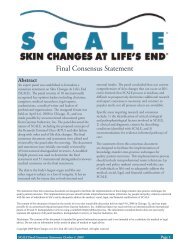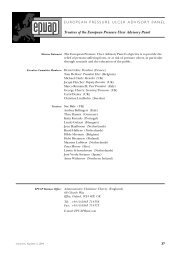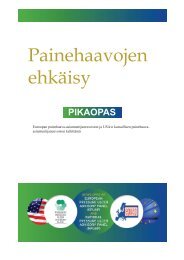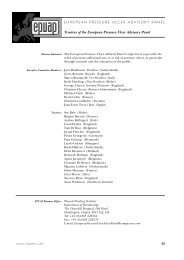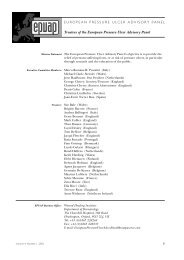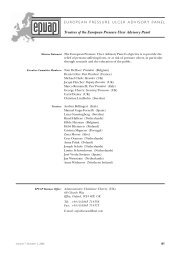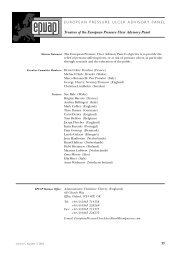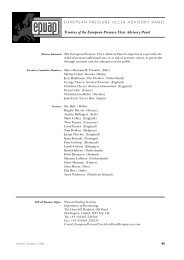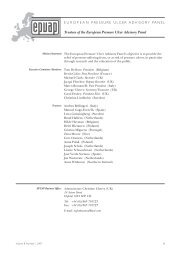EPUAP Review 10.1.indd - European Pressure Ulcer Advisory Panel
EPUAP Review 10.1.indd - European Pressure Ulcer Advisory Panel
EPUAP Review 10.1.indd - European Pressure Ulcer Advisory Panel
You also want an ePaper? Increase the reach of your titles
YUMPU automatically turns print PDFs into web optimized ePapers that Google loves.
PRESSURE ULCER PREVENTION GUIDELINES<br />
REPOSITIONING EDUCATION<br />
AND TRAINING<br />
SUPPORT SURFACES<br />
6. Education in the role of repositioning in pressure ulcer prevention<br />
should be offered to all persons involved in the care of individuals at<br />
risk of pressure ulcer development, including the individual and significant<br />
others (where possible). (Strength of Evidence = C)<br />
6.1. Training in the correct methods of repositioning and use of<br />
equipment should be offered to all persons involved in the care of individuals<br />
at risk of pressure ulcer development, including the individual<br />
and significant others (where possible and appropriate). (Strength of<br />
Evidence = C)<br />
1. General Statements<br />
1.1. Prevention in individuals at risk should be provided on a<br />
continuous basis during the time that they are at risk. (Strength of<br />
Evidence = C)<br />
1.2. Do not base the selection of a support surface solely on the<br />
perceived level of risk or the Category of pressure ulcer. (Strength of<br />
Evidence = C)<br />
Selection of an appropriate support surface should also take into<br />
consideration factors such as the individual’s level of mobility within<br />
the bed, comfort, need for microclimate control and the place and<br />
circumstances of care provision.<br />
1.3. Do not use either the perceived level of risk or Category of<br />
pressure ulcer to select a support surface. (Strength of Evidence = C)<br />
1.4. Choose a support surface compatible with the care setting.<br />
(Strength of Evidence = C)<br />
Not all support surfaces are compatible with every care setting. Support<br />
surface use in a home setting requires consideration of the weight of<br />
the bed and structure of the home, width of doors, and availability of<br />
uninterrupted electrical power and promoting ventilation of heat from<br />
the motor.<br />
1.5. Examine the appropriateness and functionality of the support<br />
surfaces on every encounter. (Strength of Evidence = C)<br />
1.6. Verify that the support surface is within its functional life span,<br />
through the specific manufacturer’s recommended test method (or<br />
other industry recognized test method) before use of the support<br />
surface. (Strength of Evidence = C)<br />
2. Mattress and Bed Use in <strong>Pressure</strong> <strong>Ulcer</strong> Prevention<br />
2.1. Use a higher specification foam mattresses rather than standard<br />
hospital foam mattresses for all individuals assessed as at risk for<br />
pressure ulcer development. (Strength of Evidence = A)<br />
Higher specification foam mattresses seem to be more effective in<br />
preventing pressure ulcers than standard hospital foam mattresses.<br />
2.2. There is no evidence of the superiority of one high specification<br />
foam mattress over alternative high specification foam mattresses.<br />
(Strength of Evidence = A)<br />
There seems to be no clear difference in the effectiveness of high<br />
specification foam mattresses.<br />
2.3. Use an active support surface (overlay or mattress) for patients<br />
at higher risk of pressure ulcer development where frequent manual<br />
repositioning is not possible. (Strength of evidence = B)<br />
Volume 10, Number 1, 2009 11



